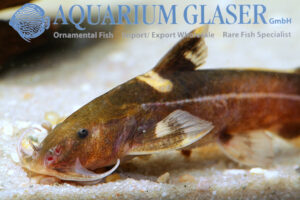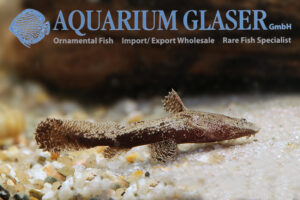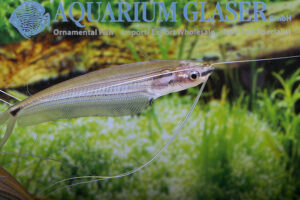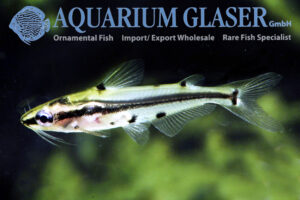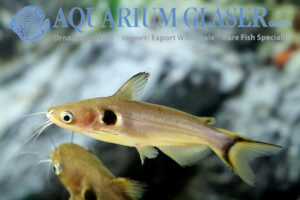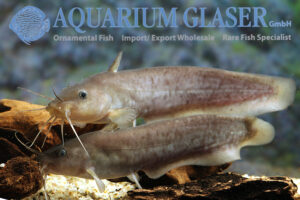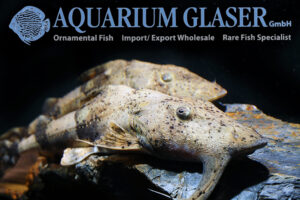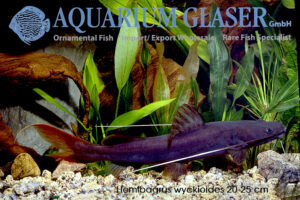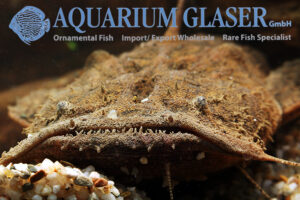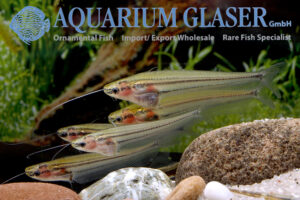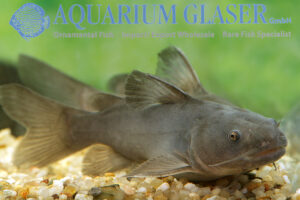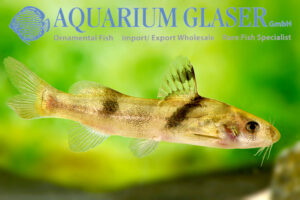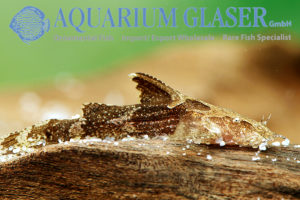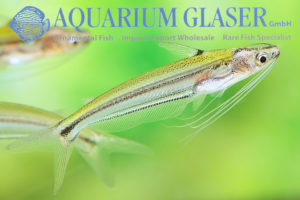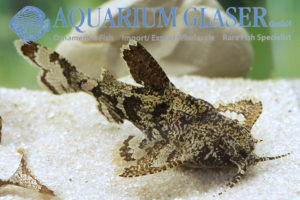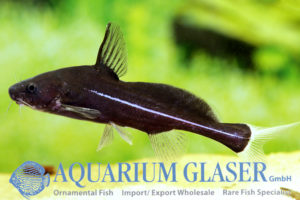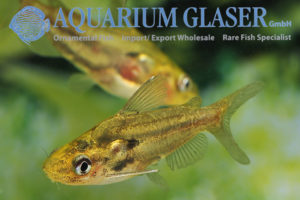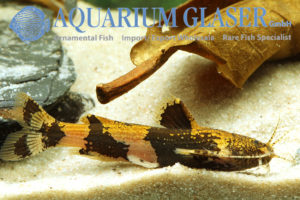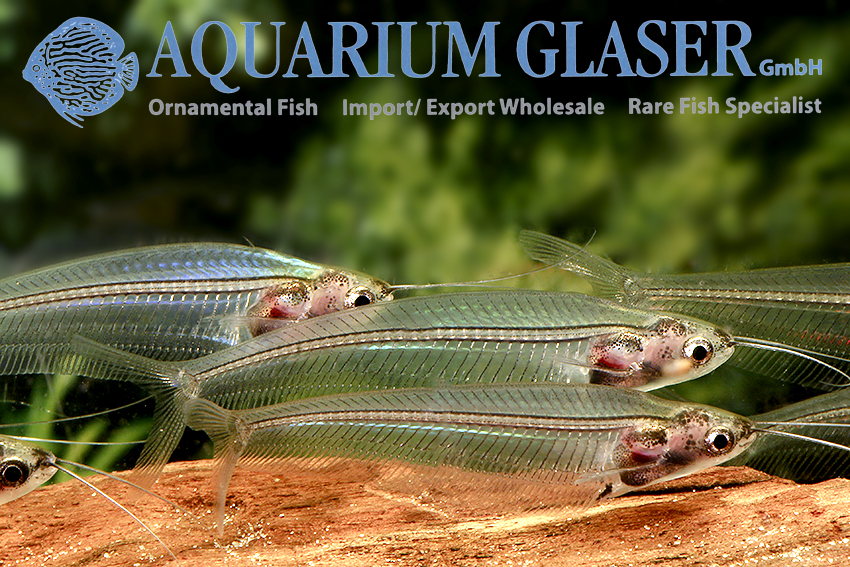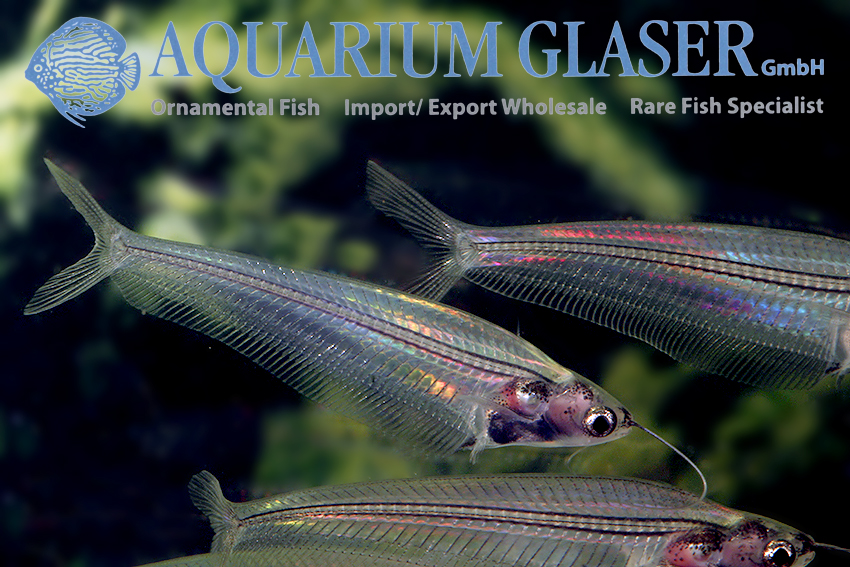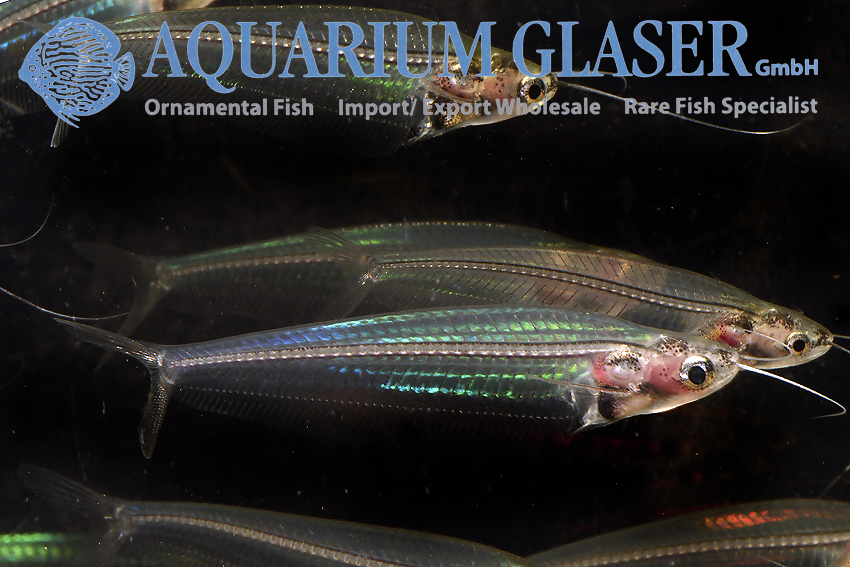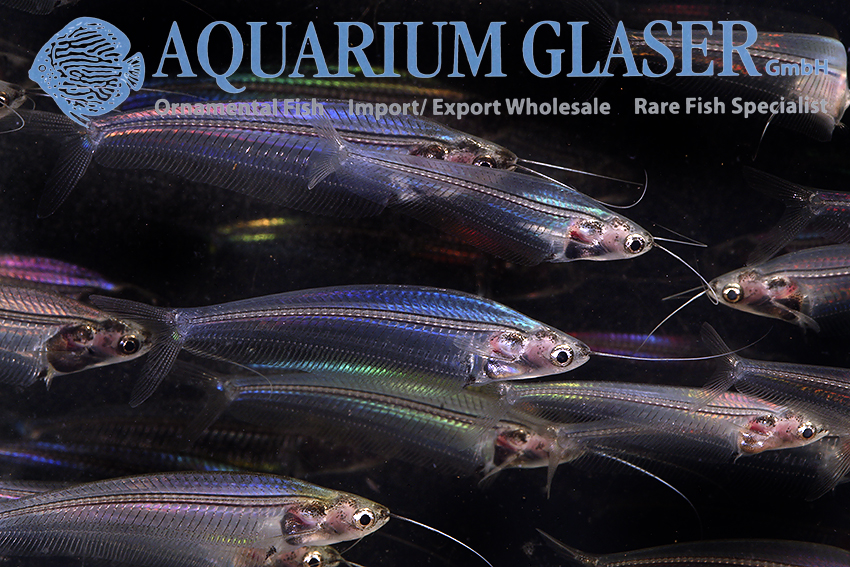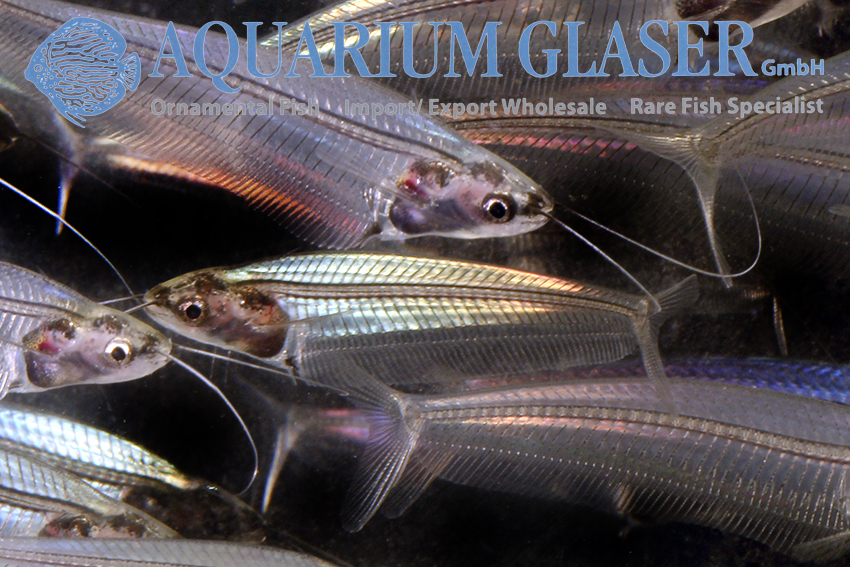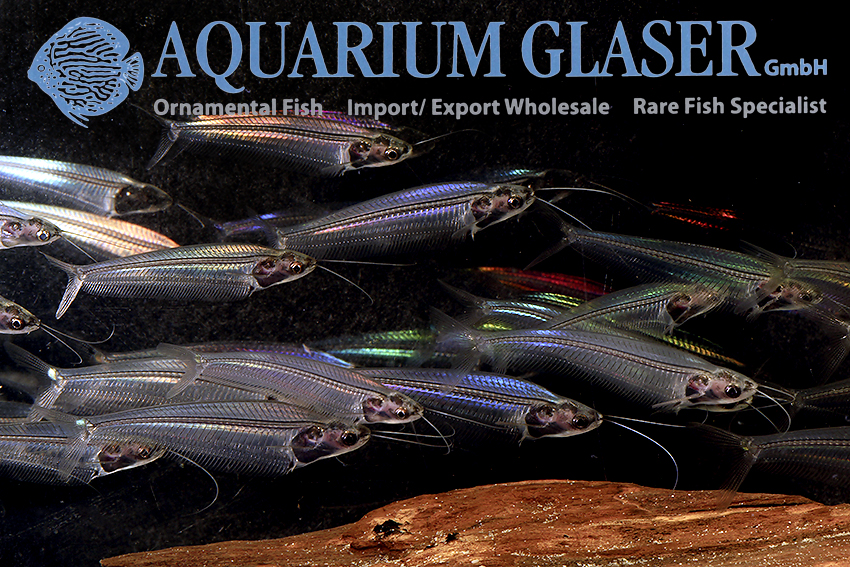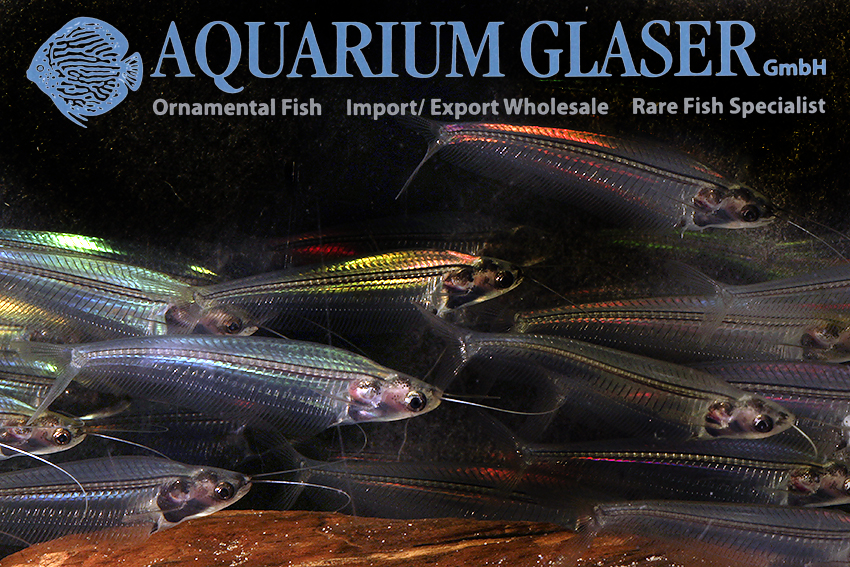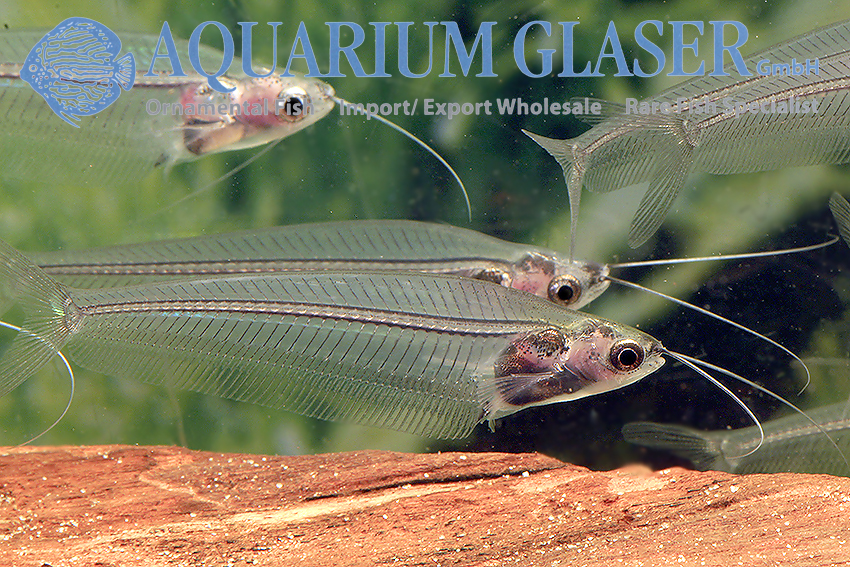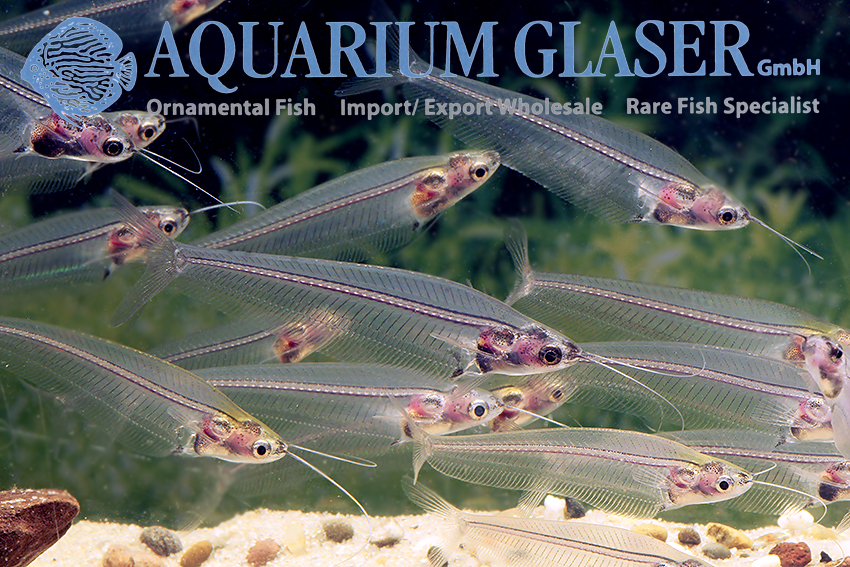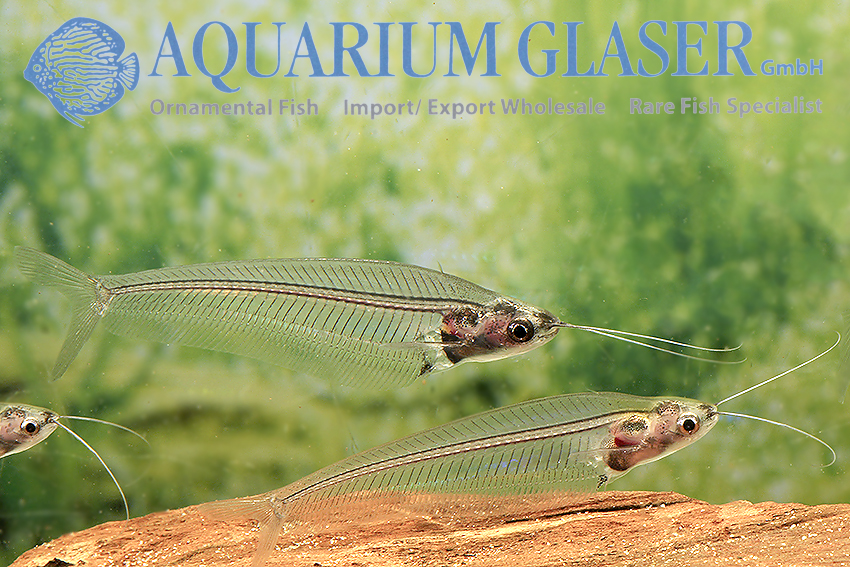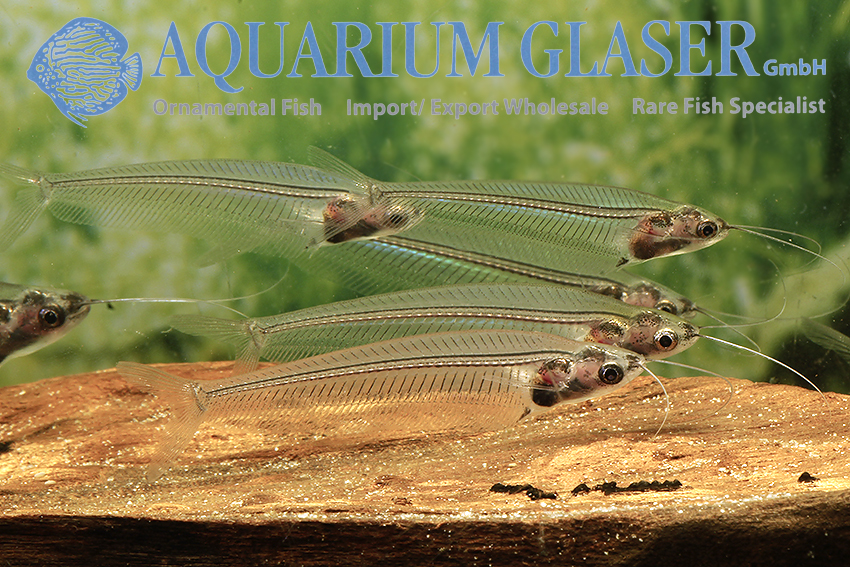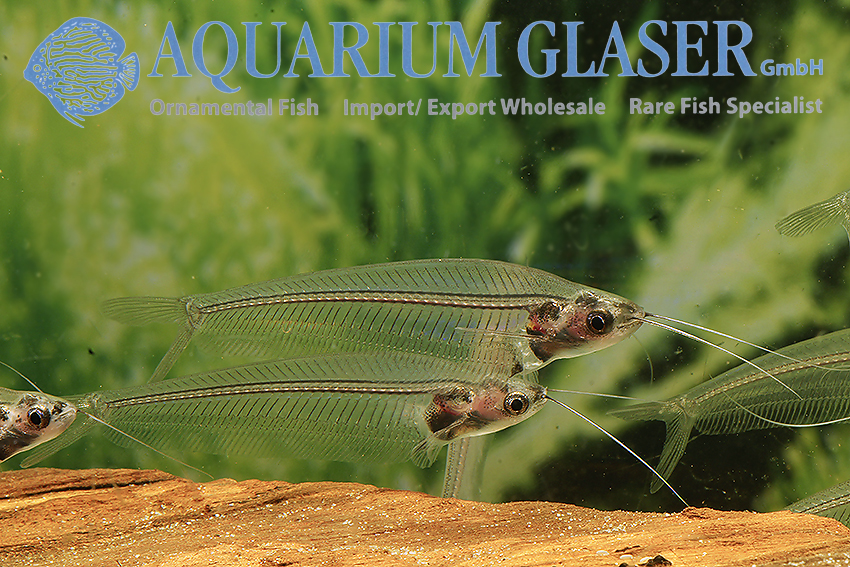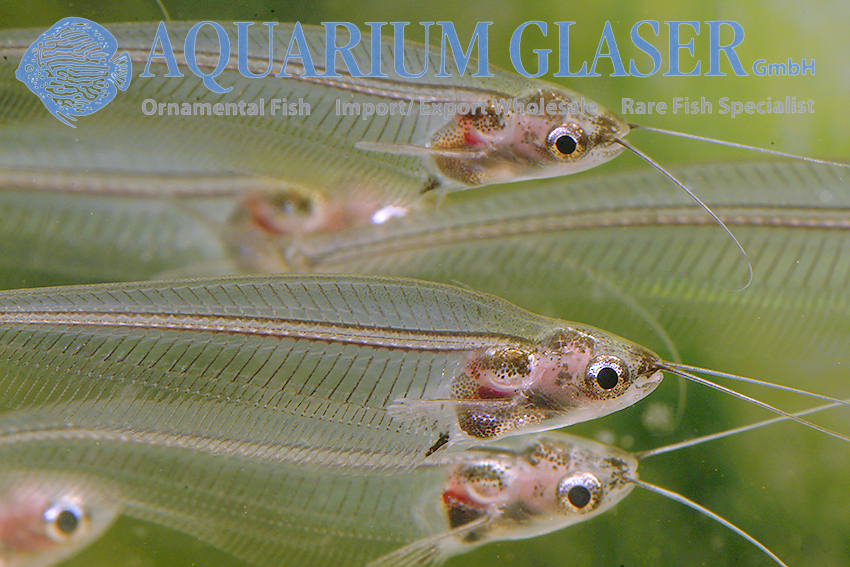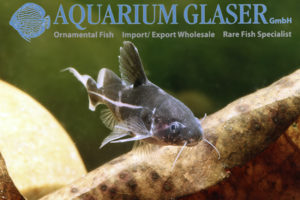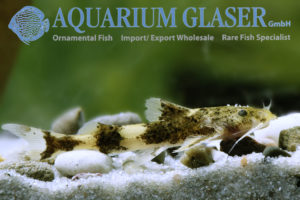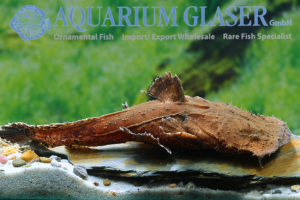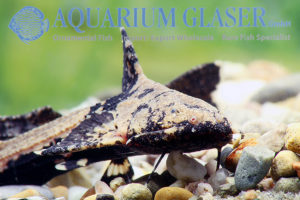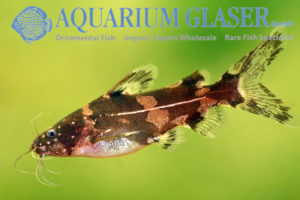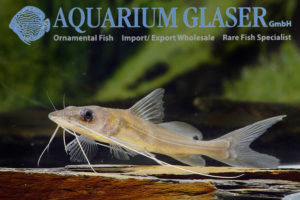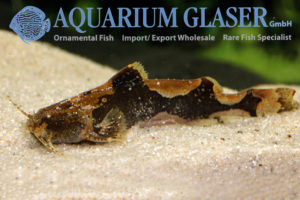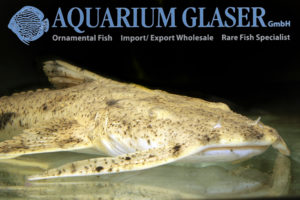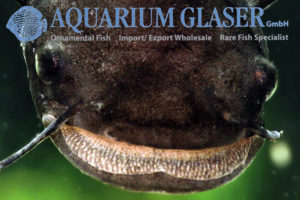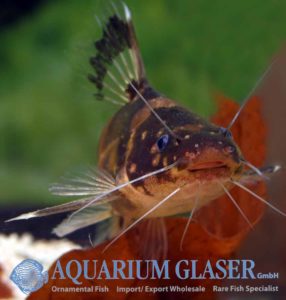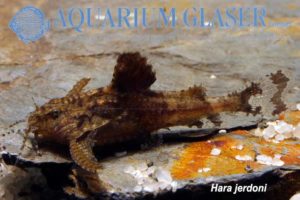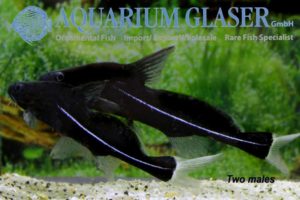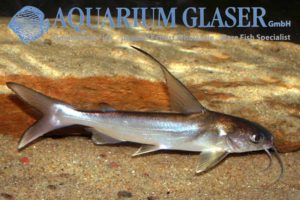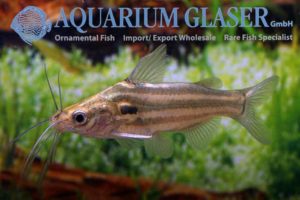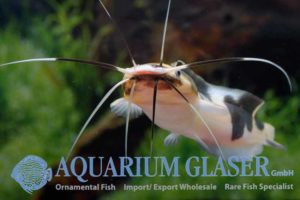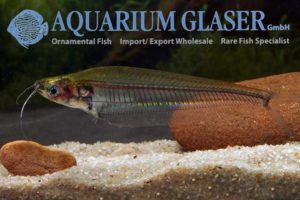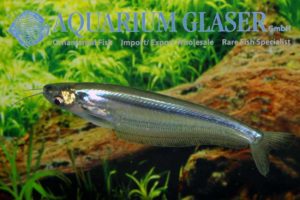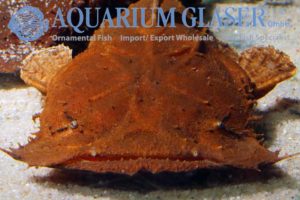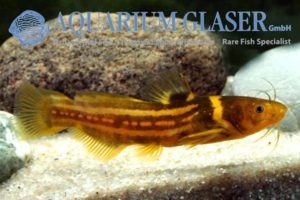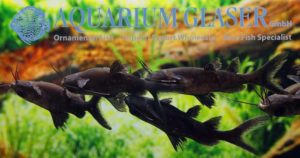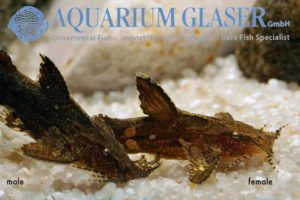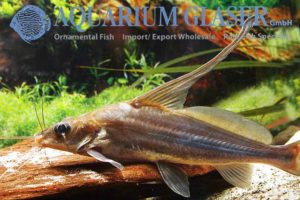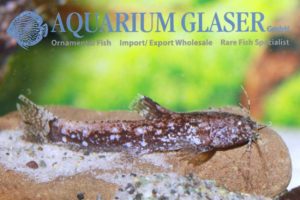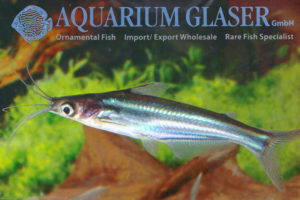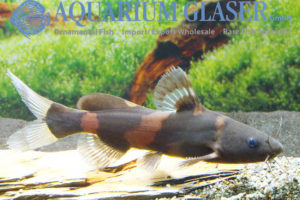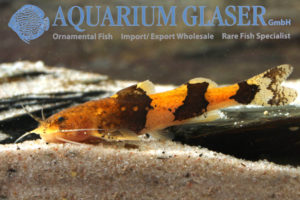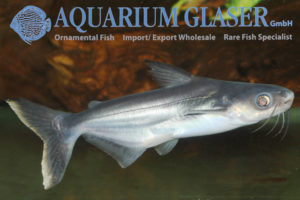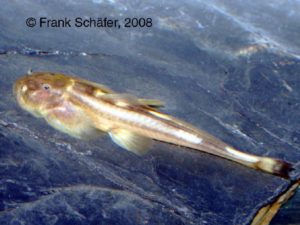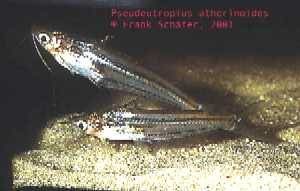The mountain catfish (Glyptothorax) are virtually unknown in aquaristics. It is a very species-rich group (almost 120 accepted plus presumably numerous undescribed species) of mostly small, current-loving catfish. The extremely limited experience of keeping these catfish shows that (as with many stream fish) they are sensitive animals that do not tolerate heavy organic pollution or […]
10e. Catfishes from Asia (54)
-
-
Chaca chaca GERMAN BRED
Frogmouth catfish (Chaca) are rarely kept in the aquarium and even more rarely bred. There are four species: Chaca chaca from India, C. burmensis from Burma, C. bankanensis from Malaysia and parts of Indonesia and C. serica from south of Borneo. The four species look very similar and were not distinguished from each other for […]
-
Ompok pinnatus
Occasionally we receive a very unusual glass catfish from Thailand, whose incredibly long barbels immediately catch the eye. This is the species Ompok pinnatus, which was only described in 2003. These fish have little in common with the Ompok we usually import (see https://www.aquariumglaser.de/en/10-catfishes/10e-catfishes-from-asia/ompok_cf_fumidus_en/ and https://www.aquariumglaser.de/en/10-catfishes/10e-catfishes-from-asia/ompok_bimaculatus_and_o_pabda_en/), they look more like typical glass catfish (Kryptopterus), which […]
-
Hyalobagrus flavus
Back in 1903 Georg Duncker from the Hamburg Museum described a small species of catfish from the Malay Peninsula under the name of Pseudobagrus ornatus. The description appeared in the same famous paper in which the harlequin barb (Trigonostigma heteromorpha) and the dwarf rasbora (Boraras maculatus) were described. In contrast to the two barbs, which […]
-
Horabagrus brachysoma
The catfish fauna of Asia is very species-rich and includes several hundred species, but only very few of these are kept in aquaria on a fairly regular basis. The genus Horabagrus is endemic (= only found there) to southern India. There are only two accepted species in this genus, namely H. brachysoma and H. nigricollaris. […]
-
Neosilurus ater
Catfish are an incredibly successful group of fish and have conquered practically all freshwater habitats. Only the sea catfish (Ariidae, the only true ornamental fish in this family is the Colombian mini shark) and the eel catfish (Plotosidae) are true marine fish, with around 30 of the 40 or so species of eel catfish regularly […]
-
Bagarius vegrandis
The devil catfish (Bagarius) is one of the largest representatives of catfish in South and Southeast Asia: giant 2-meter specimens of the Goonch – as the animals are called in India – have been caught. Unfortunately, the systematics of Bagarius are highly confused. Only one species is very well defined and clearly recognizable: B. suchus […]
-
Hemibagrus wyckii and H. wyckioides
These large predatory catfish from Southeast Asia usually grow to around half a meter in length. The maximum length given for H. wyckioides is up to 130 cm and 86 kg in weight, while “only” around 90 cm is given for H. wyckii. They are important food fish and are highly prized for their excellent […]
-
Chaca chaca
These catfish have their funny name due to the fact that they make croaking sounds when taken out of the water. These sounds are decribed onomatopoeicly as „chaca“ by the natives. Usually Chaca chaca is imported from Bengal; the species is pretty common, but only seldom available, as it is not eaten by the local […]
-
Kryptopterus macrocephalus
This close relative of the well-known and popular glass catfish Kryptopterus vitreolus (formerly: K. bicirrhis) is widespread in Southeast Asia. We have now been able to import this pretty species once again from Indonesia. The main difference between the glass catfish and K. macrocephalus is that K. macrocephalus has two dark stripes along the body. […]
-
Rita rita
The Rita catfish, Rita rita, is one of the most sought-after food fish in the Ganges-Brahmaputra system in India, Pakistan and Bangladesh. Although the species has a large distribution area and is classified as “least concern” overall, certain local populations are apparently overfished. This species, which reaches a length of up to 150 cm, is […]
-
Batasio fasciolatus
For the first time ever we obtained a species of Batasio from North Bengal in India. They belong to the species Batasio fasciolatus, which was described scientifically only in 2006. One can see that the determination of species of Batasio is not that easy keeping in mind that B. fasciolatus was already subject of an […]
-
Pseudolaguvia muricata
In recent years many highly interesting catfish species ideally suited for aquaristics have been discovered from Asia and imported for aquarists. The first species of the genus Pseudolaguvia were described already in 1927, but only recently it was recognized that this is a very species-rich genus of dwarf catfishes, which usually grow only about 2-3 […]
-
Pseudeutropius moolenburghae
From Indonesia we received the interesting catfish Pseudeutropius moolenburghae. This shoaling fish, which grows to a maximum length of 10 cm, is very similar in behavior to the well-known glass catfish Kryptopterus vitreolus (formerly known as K. bicirrhis), but is slimmer, livelier and above all has eight long barbels, while the glass catfish has only […]
-
Hara hara/Erethistes pusillus
In India live two species of moth catfishes, which are practically impossible to distinguish in living condition. They are nevertheless sometimes even assigned to two different genera: Hara and Erethistes. The difference between the two genera lies in the structure of the vertebral body, that is, of something invisible in the living animal; according to […]
-
Bagrichthys macracanthus
Bagrichthys macracanthus is a very interesting catfish from Southeast Asia (East Sumatra). This catfish reaches a maximum length of about 20 cm. In nature it lives in calm river sections. Among themselves, especially the males are quite incompatible, in pairs or in groups of a male with a surplus of females maintained, however, the species […]
-
Chandramara chandramara
In 1822, the most comprehensive book on the fish life of the Ganges River in India to date was published. The author was the Scottish physician Francis Hamilton, who was in the service of the East Indian Company. Hamilton had detailed drawings made of all the fish species he found in the Ganges. His draftsman […]
-
Akysis prashadi
The range of small, peaceful catfishes from Asia is much smaller than from South America, but they do exist. Moth catfishes (Hara, Erethistes) for low flow aquariums and wasp catfishes (Akysis) for tanks with more flow are becoming increasingly popular. Akysis get their name “wasp catfish” from the most famous species, Akysis vespa, whose sting […]
-
Bagrichthys macracanthus
We have received juveniles of the “Black Lancer” from Indonesia. The adult fish is pitch black with a white caudal fin and a narrow white horizontal stripe running along the middle of the body. The stripe begins below the dorsal fin and extends into the caudal peduncle. The 4-6 cm juveniles of this up to […]
-
Glyptothorax cf. housei
The belly sucker catfishes (Glyptothorax) are almost unknown in aquaristics. It is a very species-rich group (over 100 accepted plus probably still numerous undescribed species) of mostly small, current-loving catfishes. The extremely sparse care experiences with these catfishes show that they are (as with many stream fishes) sensitive animals, which tolerate neither stronger organic pollution […]
-
Chaca bankanensis “Sumatra”
This week we received a good number of the interesting frogmouth catfishes of the species Chaca bankanensis from Sumatra. In contrast to the rather reddish animals we could import earlier (https://www.aquariumglaser.de/en/fish-archives/chaca_bankanensis_en/), this time they are rather brown-black colored, probably an origin-related color characteristic. Very interesting is that some animals have striking white colored eyes. At […]
-
Acrochordonichthys rugosus
If this catfish came from South America, then one would count it without question to the banjo catfish. But in reality, Acrochordonichthys rugosus comes from Southeast Asia, where it is widespread and science has known about it for a long time, but from where it is only rarely exported as an aquarium fish. A special […]
-
Pseudomystus funebris
Again we could import a cute blackwater dwarf catfish from Indonesia, this time from Borneo. Pseudomystus funebris was only scientifically described in 2010 and is extremely similar to P. heokhuii which occurs on Sumatra. Like the latter, it reaches a total length of about 6 cm. The species is very peaceful and also constantly on […]
-
Sperata acicularis
The catfish of the genus Sperata can be easily identified due to the black spot in the adipose fin. Determination of the the four currently accepted species, on the other hand, is a tricky thing. Only S. seenghala, a widespread species from India, can be comparatively easily identified, because in that species the eye is […]
-
Akysis portellus
The wasp catfishes (Akysis) become more and more popular in the aquarium hobby. Their common name refers to venomous glands these fishes have at the base of the dorsal and the pectoral fins. A sting by the spines of these fins is very painful, though it it is harmless; only allergy sufferers should be double […]
-
Bagarius suchus
There are currently four species placed in the genus Bagarius, which are called devil catfish. The biggest one, which grows up to 200 cm in length, is Bagarius yarelli. It can be found in many parts of south and south-east Asia. The smallest is Bagarius bagarius, which grows up to only 15-20 cm and comes […]
-
Wallagonia micropogon
This is a fish like an evening in a swamp: dark and spooky. Wallagonia micropogon is a predator, anyone can see. The validity of the species W. micropogon is the subject of controversial discussion, many scientists believe that it is a synonym of Wallagonia leerii. Our specimens originate from Thailand. Currently they are small, only […]
-
Pseudomystus heokhuii
This pretty species of bumblebee catfish was discovered and scientifically described only in 2008. We could import the species now for the first time ever. P. heokhuii becomes about 6 cm long and is a very peaceful species of catfish. Despite the fact that Pseudomystus heokhuii inhabits extreme blackwater habitats in the wild, where the […]
-
Hara jerdoni
Currently is the high season for the interesting moth cats (Hara). These catfish occur in India, Burma, and Thailand. The species are very difficult to tell apart, in many cases it is simply impossible in live animals. There are a few species that can be determined by a filament on the caudal fin, but most […]
-
Gagata cenia
The Assamese Clown Catfish is the perfect choice for all aquarists that love lively species. This catfish attains a maximum length of about 15 cm, but matures at a length of less than 7 cm. The fish is a real energy pack. It can be hardly ever found resting for a minute, it is always […]
-
Bagrichthys macracanthus
Currently we can offer a very seldom imported, unusual catfish from Southeast Asia (eastern Sumatra): Bagrichthys macracanthus. This catfish attains a maximum length of about 20 cm. In the wild, the species inhabits river portions with only very low current. Against conspecifics males are quite quarrelsome; kept by pair or in groups composed of one […]
-
Ompok bimaculatus and O. pabda
Ompok are medium sized catfish that reach a length of 15-40 cm. They are close relatives of the only central European species of catfish, the Wels (Silurus glanis). Ompok look quite similar to the Wels. In southern and southeastern Asia, Ompok are favorite food fish, despite the fact that they are comparatively small. They are […]
-
Nemapteryx nenga
This beautiful “freshwater shark” reached us from India. Formerly the species was placed in the genus Arius. Like all these Arius-relatives Nemapteryx nenga is not a shark at all, but a catfish. N. nenga attains a length of about 30 cm and should be kept in large aquaria only. These “freshwater sharks” are animals that […]
-
Mystus tengara (M. carcio)
We received the smallest of the striped catfish species from India, which were all called formerly “Mystus vittatus”. The small species also had to face a real mess regarding the correct naming. For a long time the small species was called M. tengara, currently most scientists believe that the correct name has to be M. […]
-
Clarias batrachus marbled
Sometimes it is almost impossible to distinguish between a food fish and an ornamental fish. The marbled Clarias is, however, bred in Southeast Asia as a food fish for human consumption. It grows extremely fast, is very hardy and can survive on the market without water for many hours, because it has an accessory breathing […]
-
Kryptopterus minor
The “Ghost catfish” has been kept for more than 80 years under a wrong name in our tanks. Initially it was determined as Kryptopterus bicirrhis, afterwards as K. minor. However, both determinations proofed to be wrong, the species was in fact new to science and still undescribed! Now it has a final name, ie Kryptopterus […]
-
Kryptopterus geminus
The glass catfishes of the genus Kryptopterus are close relatives of the Wels catfish (Silurus glanis). However, in contrast to this giant among the freshwater fishes (Wels catfish can attain a length of up to 2 meteres), the glass catfishes stay small. The largest species known so far (K. cheveyi from the Mekong basin) becomes […]
-
Chaca bankanensis
The frogmouth catfishes of the genus Chaca are very unusual fish. Only four species are known. The look quite similar to each other and form a catfish family on their own, the Chacidae. Chaca lie on the bottom without any move for most of the day. They wait for shrimps or small fish that take […]
-
Ompok cf. fumidus
We don´t always get what we want. Initially we ordered the Malayan Giant Catfish Wallago leerii for one of our customers. But we received a species of Ompok from our Singapore supplier instead. However, this error is understandable. Even professional scientists have in the past confused both genera quite often and described a number of […]
-
Tachysurus fulvidraco
We were able to import a second, beautiful Chinese catfish after Pseudobagrus trilineatus (see http://www.aquariumglaser.de/en/pseudobagrus-trilineatus_de_1581.html).Trachysurus fulividraco becomes about 12-15 cm long and is a perfect catfish for larger, unheated aquaria.The species is also often placed in the genus Pelteobagrus, but the international trade name is much more interesting: Chinese highway catfish! However, the scientific name […]
-
Pseudobagrus trilineatus
This very interesting catfish originates from China. We received our first importation of the species now. The fish become about 7.5 cm long and live endemically (= they occur nowhere else) in the Dong Jiang influence in the Chinese province of Guangdong. There is no universal agreement among ichthyologist in which genus this fish should […]
-
Mystus leucophasis (formerly: Heterobagrus leucophasis)
The Upside-Down-Cat from the Congo (Synodontis nigriventris, see http://www.aquariumglaser.de/en/news/Synodontis_nigriventris_finally_available_again__en/) is known by any aquarists child. But even experienced aquarists often don´t know that in Asia (in Burma) also occurs an upside down swimming species: Mystus leucophasis which can attain a maximum length of about 30 cm, but is commonly found 15-20 cm long. The schooling […]
-
Pseudolaguvia muricata
Catfishes from Asia are sadly not “en vogue” currently. On the other hand, many new, attractive species have been discovered recently, which are perfect aquarium inhabitants. The first species of the genus Pseudolaguvia was discovered back in 1927, but only recently it was found that this genus represents a species-rich one. Pseudolaguvia are dwarf catfish […]
-
Wallago attu
We had to try quite long, but finally we succeeded and could import some youngsters of one of the most voracious of all predatory Asian catfishes again. Wallago attu attains a maximum length of about 2 m. The enormous mouth extents far behind the eyes and it contains a large number of spiky teeth. The […]
-
Mystus bocourti
Due to its extremely prolonged dorsal fin this fascinating species has also been placed in a genus on its own for a long time, namely Heterobagrus. The catfish becomes around 20-25 cm long. It is a very peaceful species; however, fish of small size will be taken as food, but neither congeneers nor any other […]
-
Parakysis verrucosus
For the first time ever we received this tiny and charming dwarf fish from Malaysia. It reaches only 3-4 cm in length. The species is adopted to black water habitats in nature, where the water is very soft and acidic. However, in our facility they have proofed so far to be unproblematic and quite gregarious. […]
-
Pseudeutropius – the mini shark cats
The shark cats belonging to the genera Pangasius and Pangasianodon are very popular. The reason is their interesting swimming behaviour which reminds one in sharks. However, these fish have one big disadvantage: they grow to a very large size. Even the smallest of them, the common Siamese shark Pangasianodon hypophthalmus, becomes at least 30 – […]
-
Pseudomystus siamensis (= Leiocassis siamensis)
It has been some time that we had this good old fashioned classic from Southeast Asia in our fishhouse. Pseudomystus siamensis originates from Thailand, Cambodia, and Laos and is a smaller species of catfish. Maximum length given in literature is 15 cm, but this length is hardly ever reached. Against congeneers and other species of […]
-
Akysis vespa
Among the catfishes are several species that are able to take revenge for being caught by giving a poisonous sting. Although the venom has only mild effects on most people (burning, local swelling, pain) it might be even fatal for allergy sufferers. You should always keep in mind that our beloved honey bee is the […]
-
Pangasius bocourti
Shark catfishes have received their common name according to their swimming behaviour, which is very similar to the way several species of shark do swim. Similar to sharks is also that the fishes do permanently swim and only seldom take a rest.Nowadays they are also well known by their scientific genus name, eg Pangasius, because […]
-
Oreoglanis siamensis
(21.April 2008)…and again we got something very rare: Oreoglanis siamensis. But only a very few pieces. They live in the Mekong area and the Chao Phyraya basins. In the northern part of Thailand you can find them in the mountain area of Mae Nam Ping and Doi Chiang Dow. They are found in fast floating […]
-
Pseudeutropius atherinoides
The „shark cats“ of the genus Pangasius are highly seeked for aquarium fishes, because their swimming behaviour reminds one on a shark. Sadly all species grow very fast and none of the species stays smaller than 50 cm, some even reach 150 cm or even more. For some time now so-called „mini-pangasius“ are introduced to […]
Kryptopterus vitreolus
The common glass or ghost catfish, Kryptopterus vitreolus, has been swimming in numerous aquariums around the world for decades, albeit mostly under the misnomer K. bicirrhis (see https://www.aquariumglaser.de/en/fisharchives/a_new_name_for_the_ghost_glass_catfish_kryptopterus_vitreolus_en for details). We have the animal practically always in the stock.
One of the absolute routine measures in the everyday care of the fish is to examine it regularly in the beam of a strong flashlight for possible disease. In this context, one of our keepers, Martin Möller (who has a degree in biology), made the discovery that under certain light incidence, the glass catfish show a distinctly colorful iridescence. This is basically the same effect of light refraction that leads to the formation of rainbows. However, it is not easy to capture it photographically, because the interaction of light and movement of the fish must fit absolutely. After many unusable pictures, however, we finally succeeded in depicting the Möller effect. Fascinating, to say it with Mr. Spock!
For our customers: the animals have code 422005 on our stock list. Please note that we only supply wholesale.
Text & photos: Frank Schäfer
A new name for the Ghost glass catfish: Kryptopterus vitreolus

This extraordinary catfish is a popular aquarium inhabitant for more than 80 years now. The scientists Heok Hee Ng and Maurice Kottelat found out that it has been mis-identified over eight decades as Kryptopterus bicirrhis or K. minor and that the Ghost glass catfish represents a so far undescribed species. They named it as Kryptopterus vitreolus now.

Kryptopterus bicirrhis looks very different. It is not that translucend. K. bicirrhis becomes about 15 cm long which is much more that K. vitreolus (about 7 cm). The K. bicirrhis we show here was a by catch in our K. vitreolus which we currently offer in show size. K. minor originates from the island of Borneo and has in all probabilty never been imported as an ornamental fish. K. vitreolus originates from Thailand only.

For our customers: the fish has code 422005 on our stocklist. Please note that we exclusively supply the wholesale trade.
Lexicon: Kryptopterus: ancient Greek, means “with hidden fin”. bicirrhis: Latin, means “with two filaments”. minor: Latin, means “small”. vitreolus: Latin, means “small glass”.
Text & photos: Frank Schäfer





